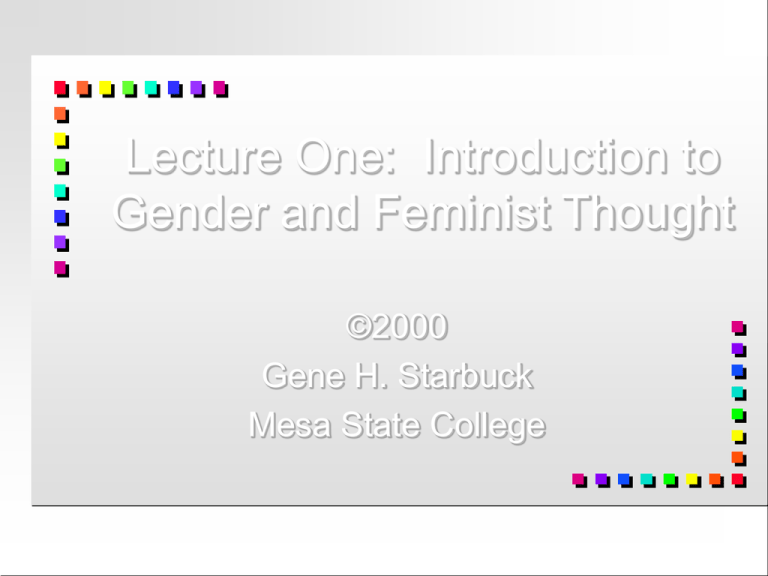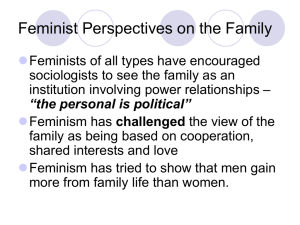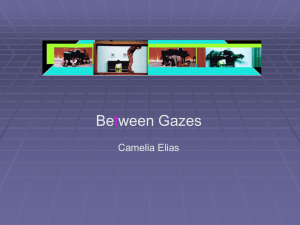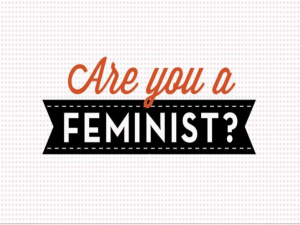sglect1
advertisement

Lecture One: Introduction to Gender and Feminist Thought ©2000 Gene H. Starbuck Mesa State College Gendered Options Sex Biological distinction of being male or female Gender Social distinctions of being masculine or feminine The Race/Class/Gender Trilogy Major topic in sociology today What do the three concepts have in common? Ways of organizing power/ rewards/ DOL relationships in society Hierarchical structures How are they different? Feminists “attached” gender to race and class Moral capital in social change movements Gender as Social Class: Problems in Conceptualization Women as proletariat in two gender/class system? Same relationship to modes of production (Marx)? Same probability of using goods and services (Weber)? Is there “class homogamy” in mate selection? Is there “gender class class mobility?” Through what mechanisms is cultural capital passed on? What are “Class-Irreducible Roles” Gender as Race: Problems in Conceptualization Women as devalued race in racist system? Similarities: Biological component can lead to social devaluation Problems: Is the “race” passed on through biological reproduction? Is there “racial homogamy?” Gender and Prestige Traditional models of occupational status had difficulties with married women’s status. Usually: Status-Borrowing Model Applies to homemaker, part-time employed Alternative: Status-Maximization Strategy Husband’s status dominates in U.S., Sweden, Norway, Australia (Baxter, 1994) John Money’s Four Gender Gender-Role Identity/Roles DistinctionsContinuum Sex-irreducible gender roles Secondary sex characteristics; balding, aggression? Sex-adjunctive gender roles Men impregnate; women menstruate, gestate, and lactate. Sex-derivative gender roles Nature Urinary posture; big-game hunting, “mothering,” Sex-arbitrary gender roles Little social impact of reversal Flutes and trumpets Math? Nurture Feminist Thought History Greeks Lysistrata: Aristophanes--women end Peloponesian war Medea: Euripides Abolitionist movement, mid 19th century; suffrage until 1920 The “Second Wave” late 1960s Types of Feminism (mostly from Tutle, Lisa (1986) Encyclopedia of Feminism. New York: Facts on File.) Dictionary Definition: “Belief in the social, political, and economic equality of the sexes” In social science, it means more than that. Several branches of feminism, following Liberal Feminism 18th century Liberal thought Mary Wollstonecraft A Vindication of the Rights of Women (1792) John Stuart Mill The Subjection of Women (1869). 1960s Kennedy--National Commision on the Status of women--Eleanor Roosevelt Civil Rights act of 1964--concerned with extending to women the liberal values of liberty, equality and justice through legal and social reforms. Legislative and political action-- action, lobbying, courts--reformist and gradualist. Radical Feminists Late 1960s New Left civil rights and anti-war protests. Young, privileged white women in New York (Columbia) etc. Group called “The Feminists” Gender distinctions thought to be natural are actually socially and politically constructed Significant and radical change is needed in society Radical Feminists (cont.) Kate Millett (a founder of NOW) Sexual Politics “The personal is political” MEN, not just the patriarchy, at fault because all men benefit from women’s oppression. patriarchal assumptions permeate all social institutions--including marriage, family, love, heterosexuality etc. Loosely organized groups calling for complete restructuring of society: Betty Friedan (NOW); Germaine Greer, Gloria Steinem, Susan Steinmetz; Pam Allen and Shulamith Firestone--the famous “bra burning” protest at Miss America Contest in Atlantic City, New Jersey, on Sep 7, 1968. Susan Brownmiller Against Our Will: Men, Women, and Rape “Rape is the act of terror by which all men control all women” Journalist/ Humanities like many others Socialist Feminism Combining radical feminism with Marxist analysis-Overthrow both class and gender “capitalist patriarchy” Extend notions of modes of production (Marxist economic determinism) to other production--I. E. mothering Solidarity of “the sisterhood” as a world-wide “gender class”-- every issue is a women’s issue Other Feminist Schools Marxist-feminism focus on destruction of capitalism as way to liberate women. Lesbian feminism Lesbian-feminist politics is a political critique of the institution and ideology of heterosexuality as a cornerstone of male supremacy Rita Mae Brown, Charlotte Bunch, TiGrace Atkinson, McKinnon, Andrea Dworkin--Amer. Hert. dict. & Violence Against Women Act-- Adrienne Rich “Compulsory Heterosexuality and Lesbian Existence” (1980) Humanist feminism women’s oppression is the inhibition and distortion of women’s human potential by a society that allows the self-development of men. Other Feminist Schools (cont.) Black feminism reaction by black women to the middle-class, white dominance of the feminist movement. bell hooks, Audre Lorde. Eco-feminism combination of radical feminism, the ecology movement, and secular humanism. Anarcha-feminism Emma Goldman--antihierarchal, anti-authoritarian-- rid the society of dominance-submission of all kinds, including sexism, race, classism, lookism, ableism, etc. Academic Feminism: College Women’s studies, gender studies, feminist studies 1. Gynocentric focus--antidote to perceived dominance of androcentric, patriarchal history. Women’s studies 2. Emphasis on oppression of women 3. Importance of praxis 4. Distrust of traditional model of objective science. 5. Blurring of distinction between social science and literature (social constructionism, post-modernism)








